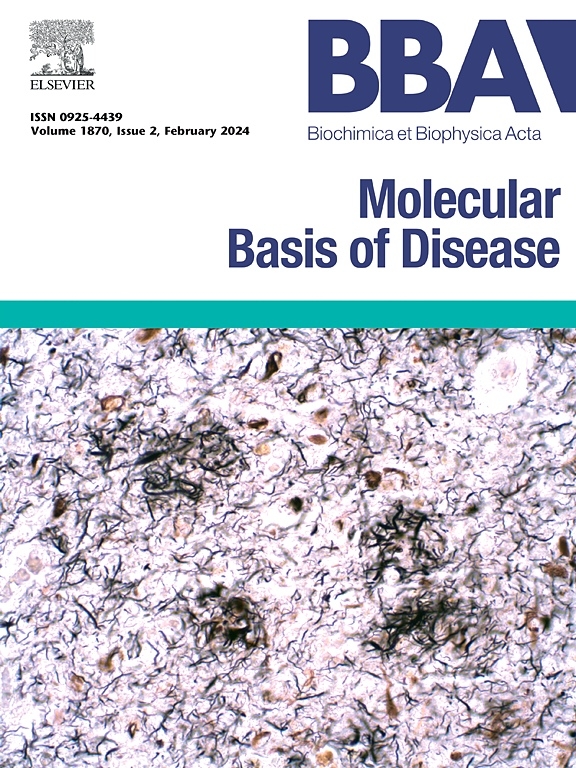Dimeric PKM2 induces ferroptosis from intestinal ischemia/reperfusion in mice by histone H4 lysine 12 lactylation-mediated HMGB1 transcription activation through the lactic acid/p300 axis
IF 4.2
2区 生物学
Q2 BIOCHEMISTRY & MOLECULAR BIOLOGY
Biochimica et biophysica acta. Molecular basis of disease
Pub Date : 2025-07-28
DOI:10.1016/j.bbadis.2025.167998
引用次数: 0
Abstract
Background
The role of Pyruvate kinase M2 (PKM2) in intestinal ischemia-reperfusion (I/R) was investigated in this study, with a focus on the mechanism of dimeric PKM2 in ferroptosis.
Methods
The in vivo and in vitro models of intestinal ischemia-reperfusion were constructed and in vitro and in vivo evaluations were performed using a variety of techniques.
Results
HMGB1 and dimeric PKM2 were highly expressed in intestinal I/R mice. Dimeric PKM2 inhibitors (ML265) and HMGB1 inhibitors (Glycyrrhizin) reduced ferroptosis in vivo and in vitro. ML265 decreased glucose uptake, lactate, GLUT1, ENO1, LDHA, and PDK1 levels. Importantly, HMGB1 knockdown completely counterbalanced the promoting effect of PKM2 overexpression on ferroptosis, while ACSL4 knockdown or GPX4 overexpression partially revoked the promoting effect of PKM2 overexpression on ferroptosis. HMGB1 overexpression completely prevented the inhibiting effect of PKM2 knockdown on ferroptosis. Lactate promoted pan kla and H4K12la levels in H/R-induced Caco-2 cells and promoted ferroptosis. ML265 reversed the phenomenon. Moreover, CoIP results showed that PKM2 directly bound to p300. ChIP-qPCR results showed that the concentration of dimeric PKM2 (and nuclear PKM2) and p300 on HMGB1 promoter increased in H/R group. ML265 reduced the enrichment of p300 on HMGB1 promoter. Sh-p300 reduced H4K12la enrichment on HMGB1 promoter. In addition, oe-p300 disrupted the effect of ML265 on H/R-induced Caco-2 cells.
Conclusions
Our results suggested that dimeric PKM2 induced ferroptosis in intestinal I/R by stimulating lactylation-mediated HMGB1 transcription activation via the lactic acid/p300 axis, which may provide new targets for treatment of intestinal I/R injury.
二聚体PKM2通过乳酸/p300轴介导组蛋白H4赖氨酸12乳酸化介导HMGB1转录激活,诱导小鼠肠缺血/再灌注后铁死亡。
背景:本研究探讨了丙酮酸激酶M2 (PKM2)在肠缺血再灌注(I/R)中的作用,重点探讨了二聚体PKM2在铁凋亡中的作用机制。方法:建立肠道缺血再灌注模型,采用多种技术进行体外和体内评价。结果:HMGB1和二聚体PKM2在肠I/R小鼠中高表达。二聚体PKM2抑制剂(ML265)和HMGB1抑制剂(甘草酸)在体内和体外均可减少铁下垂。ML265降低葡萄糖摄取、乳酸、GLUT1、ENO1、LDHA和PDK1水平。重要的是,HMGB1敲低完全抵消了PKM2过表达对铁下垂的促进作用,而ACSL4敲低或GPX4过表达部分撤销了PKM2过表达对铁下垂的促进作用。HMGB1过表达完全阻止PKM2敲低对铁下垂的抑制作用。乳酸可促进H/ r诱导的Caco-2细胞中的pan kla和H4K12la水平,并促进铁下垂。ML265扭转了这一现象。此外,CoIP结果表明PKM2直接与p300结合。ChIP-qPCR结果显示,H/R组HMGB1启动子上二聚体PKM2(及核PKM2)和p300的浓度升高。ML265降低了HMGB1启动子上p300的富集。Sh-p300降低了HMGB1启动子上H4K12la的富集。此外,e-p300破坏了ML265对H/ r诱导的Caco-2细胞的作用。结论:二聚体PKM2通过乳酸/p300轴刺激乳酸化介导的HMGB1转录激活,诱导肠I/R铁凋亡,可能为治疗肠I/R损伤提供新的靶点。
本文章由计算机程序翻译,如有差异,请以英文原文为准。
求助全文
约1分钟内获得全文
求助全文
来源期刊
CiteScore
12.30
自引率
0.00%
发文量
218
审稿时长
32 days
期刊介绍:
BBA Molecular Basis of Disease addresses the biochemistry and molecular genetics of disease processes and models of human disease. This journal covers aspects of aging, cancer, metabolic-, neurological-, and immunological-based disease. Manuscripts focused on using animal models to elucidate biochemical and mechanistic insight in each of these conditions, are particularly encouraged. Manuscripts should emphasize the underlying mechanisms of disease pathways and provide novel contributions to the understanding and/or treatment of these disorders. Highly descriptive and method development submissions may be declined without full review. The submission of uninvited reviews to BBA - Molecular Basis of Disease is strongly discouraged, and any such uninvited review should be accompanied by a coverletter outlining the compelling reasons why the review should be considered.

 求助内容:
求助内容: 应助结果提醒方式:
应助结果提醒方式:


